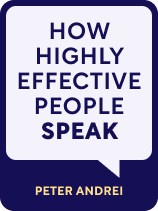

This article is an excerpt from the Shortform book guide to "How Highly Effective People Speak" by Peter Andrei. Shortform has the world's best summaries and analyses of books you should be reading.
Like this article? Sign up for a free trial here.
Does it feel like, when you speak, what you say goes in one ear and out the other? Would you like to communicate messages that people will remember?
The availability heuristic is a cognitive bias that has a dark side and a bright side. Peter D. Andrei accentuates the positive and shows how to make the most of it. He shares strategies to take advantage of the availability bias: use compelling narratives, convey simple messages, and employ imagery.
Keep reading to learn how to use the availability heuristic to make your communication unforgettable.
The Availability Heuristic
The availability heuristic is the tendency to give too much credence to evidence or information that comes most easily to mind—the evidence that’s mentally “available.” Relying on this type of information can allow us to make judgments quickly, which can be helpful but also can lead us to wrong judgments.
A classic example of this bias is in the common fear of plane crashes—a statistically unlikely event that people irrationally fear because they easily remember instances of it occurring. When you step foot on a plane, you might remember the news story you heard of a plane crash. Because it takes more time to think through the statistics about how likely such an event actually is, your readily available memory of the headline makes you worry it’s going to happen to you.
| What Makes Availability Bias So Widespread and Powerful? The availability heuristic was first researched by Amos Tversky and Daniel Kahneman in the 1970s, and their book Thinking, Fast and Slow provides some more insight into the causes, effects, and potential remedies of this bias. They write that a big driver of availability bias is the media, which often overemphasize the importance of a relatively insignificant event like a plane crash. A plane crash is, of course, tragic, but no less tragic than the estimated 3,700 daily deaths due to car accidents. But since car accidents are much more common, they’re much less likely to become a big news story and cause global fear and panic. Tversky and Kahneman also write that you’re more susceptible to availability bias under certain conditions, such as when you’re in a good mood, when you’re an amateur in a field, or when you feel powerful or successful. Being aware of this enhanced susceptibility can help you avoid falling victim to the availability bias, but you can also use it in your communication—if your speech makes the audience feel good or powerful, it’ll be more persuasive. If you’re writing about a topic in which the audience isn’t well-informed, it’ll have a greater effect. |
According to Andrei, if you want your communication to be unforgettable (and thus the most readily available), it should be emotional, simple, and vivid. He offers several strategies to imbue your speech or writing with these qualities.
Use Compelling Narratives
One of the most effective ways to make your speech emotionally stimulating is to use powerful storytelling, appealing to narrative bias. People understand the world through stories—it’s how we learn and how our ancestors passed down information over thousands of years. When an argument is presented as a story, we relate to the people in the story and imagine what it would be like if the same things happened to us. For example, when we read a news story of a plane crash, we think about how afraid the passengers must have been, and then we feel afraid ourselves. Experiencing it mentally like this makes it more memorable.
(Shortform note: Psychologists argue that narrative bias comes from our desire to find meaning in the world and to make the random and chaotic more coherent and explainable. This can be helpful in many situations. For example, when you reframe a painful memory into a more understandable and less painful story, it can be psychologically beneficial—like if you come up with a story to explain why your ex broke up with you. But narrative bias can also be harmful, like when you tell yourself you failed at a task because you’re inferior when it was actually due to randomness.)
To make your stories as emotionally compelling as possible, Andrei recommends telling a story about a single person. This makes it even easier for the listener to imagine themselves in the story. Let’s say you’re making a speech about reducing the effects of pollution on a small town near a factory. You could just provide all the facts: the higher percentages of illness, the levels of toxins in the drinking water before and after the factory was built, and the economic damage to the town.
Or, more effectively, you could tell a story about one person in the town—for instance, a single mom who got sick, had to stop working, and could no longer afford to take proper care of herself and her children. Then, when the audience is emotionally captivated, you might add in the statistics about illness percentages or toxin levels to drive the point home. This narrative-structured speech is more likely to resonate with the audience than simply stating the facts or even telling a story about how the town as a whole was affected.
| Further Tips on Emotional Storytelling Other public speaking experts go into more detail on how to make a story compelling. In Talk Like TED, Carmine Gallo recommends imbuing a story with the following characteristics: Rich detail: A detailed story is more immersive, making the audience feel like they’re experiencing it firsthand. This might be another reason the quantitative details that Andrei recommends work to enhance a story. Surprise: An element of surprise in a story will keep the audience from becoming bored and losing interest in what you’re saying. Mystery: Like a surprising story, a mystery will keep the audience guessing and engaged. People are naturally drawn to a story with an unknown outcome. Adversity: People also love having someone or something to root for. If your story has a hero trying to overcome adversity or defeat a villain, the audience will find it more interesting and feel more compelled to listen. Though Andrei recommends telling a story about a single person instead of a group of people, Gallo adds that telling three distinct stories can be even more persuasive, because three stories can drive the point home. But he recommends limiting yourself to three so that you keep your audience’s attention, which echoes Andrei’s next strategy of keeping your message simple. |

———End of Preview———
Like what you just read? Read the rest of the world's best book summary and analysis of Peter Andrei's "How Highly Effective People Speak" at Shortform.
Here's what you'll find in our full How Highly Effective People Speak summary:
- That persuasive speech is a complex craft that can be studied and learned
- How to take advantage of cognitive biases to be more persuasive
- Why trying to manipulate others' thoughts isn't inherently immoral






